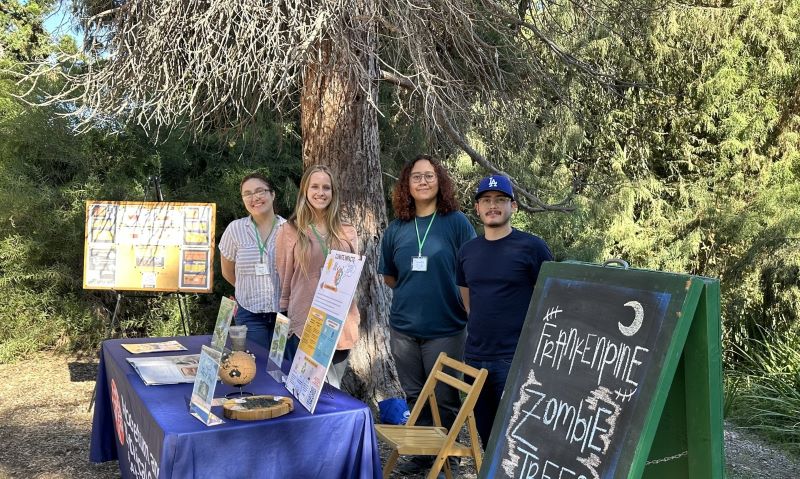
Cal State Fullerton students are part of a worldwide effort of scientists and arboreta studying the effects of climate change on plants and trees.
The Engaging Environmental Experiences Internship program at the Arboretum and Botanical Garden at CSUF provides students with opportunities to learn about horticultural practices and general ecological principles.
Each week, a team of six CSUF students, known as the climate assessment team, conduct complete health assessments and collects soil samples from various trees in the arboretum. They work the Climate Assessment Tool, an online database that gathers data from other arboreta across the world and offers a projection of how well or poorly plant species will do under different scenarios of warming under climate change.
At the Arboretum and Botanical Garden at Cal State Fullerton, tree health assessments are made under the guidance of faculty members and arboretum staff. The assessments note the health of the tree so changes can be observed over time.
“I am deeply interested in climate change and its effect on the earth’s biodiversity and food supply,” said Maya Gallardo, a junior majoring in geography. “How plants are doing in the arboretum is an indicator of how they might be doing elsewhere in similar climates.”
Gallardo said she has learned useful techniques, both in research and through fieldwork at the arboretum. “For example, cacao trees and coffee plants grow close to the equator and are experiencing negative impacts because of rising temperatures. Providing a better understanding of how food and resources are impacted by climate change makes me proud to be a member of this team,” said Gallardo.
Andrea Hoppe, a graduate student in environmental studies and the lead on the project, is responsible for guiding other students through the research process.
“My interests lie in the intersection between environmental and social well-being,” said Hoppe. “Since climate change is going to heavily impact and alter both the environment and our communities, particularly marginalized communities who are experiencing the effects of climate change with limited resources to support their recovery, being a part of this team provides me with the opportunity to more deeply understand climate change and the science behind it.”
“A ‘learn-by-doing focus’ is important in ensuring a robust academic experience, completing service-learning projects, building relationships with campus and community members, and working together to solve pressing environmental issues in the arboretum, on campus and beyond,” said Justin Villasenor, academic and environmental program coordinator at the arboretum.
“I have learned so much,” said Miranda Esteves, a junior majoring in geography. “I love working with a team that is so dedicated to this work. For example, the Botanic Gardens Conservation International climate assessment tool helps us predict how a specific tree will be impacted under different climates in the future. International Plant Health Checker’s forms are also used to assess the current health of individual trees so we can better understand how they grow under the present-day climate.”
Jacob Acosta, a junior majoring in biochemistry, performs soil sample tests on specific trees, primarily redwoods, to determine how they will withstand climate change in the coming years.
“People have this misconception that they need to change their entire way of life to combat climate change,” said Acosta. “But if everyone just chips in to help even a little, the world will be better off in the long run.”
“As warming from climate change becomes more obvious, we’ll be able to notice how the trees are changing, if they’re doing better or worse under warmer conditions and what those changes can tell us,” said Hoppe. “This can inform us as to how the arboretum can adapt by eventually replacing lost tree species or tree species with declining health with ones that will do better here with warmer temperatures.”
Completing soil samples also provides a broader look at the health of the trees and the different organisms that contribute to their well-being.
The team also engages in public events to highlight the impacts of climate change on food systems and food availability.
“Extreme heat waves, flooding, more intense hurricanes and food insecurity are all related to and exacerbated by climate change,” said Hoppe. “As we’ve already seen with the wildfires in California earlier this year, extremes are going to be more frequent as climate change progresses, and this will ultimately impact everyone.
“However, there are things that we can do to mitigate the impacts. Plant native plants that will do well in your region, advocate for green architecture, join a community garden and participate in habitat restoration projects,” said Hoppe. “Anything that an individual can do to live more sustainably and address the issues brought up by climate change is a step in the right direction. And encourage governmental bodies to do the same.
“If we use the resources available to us and acknowledge the science behind the changes, we can understand what needs to be done to continue to have natural spaces and vegetation in urban areas.”